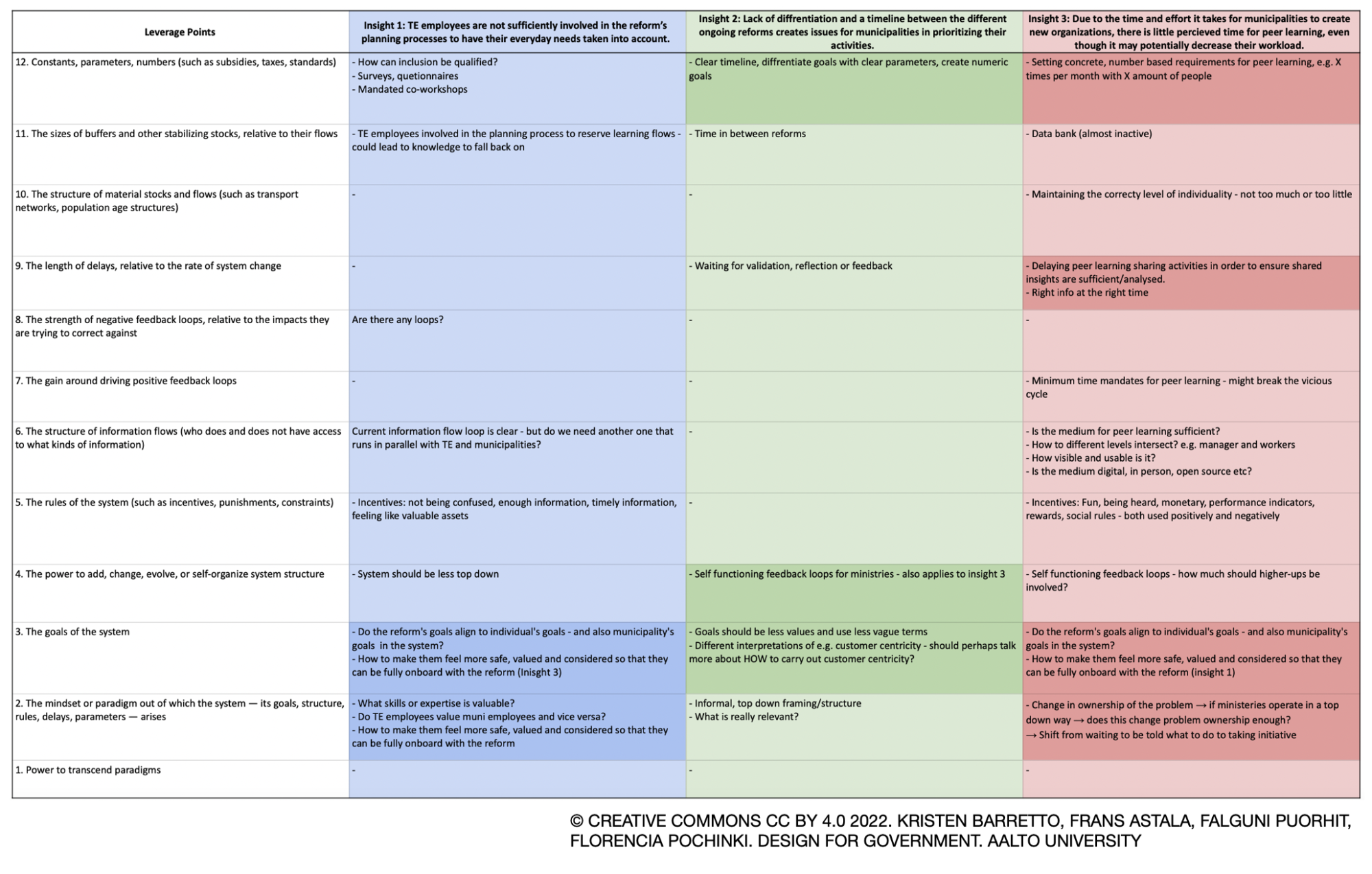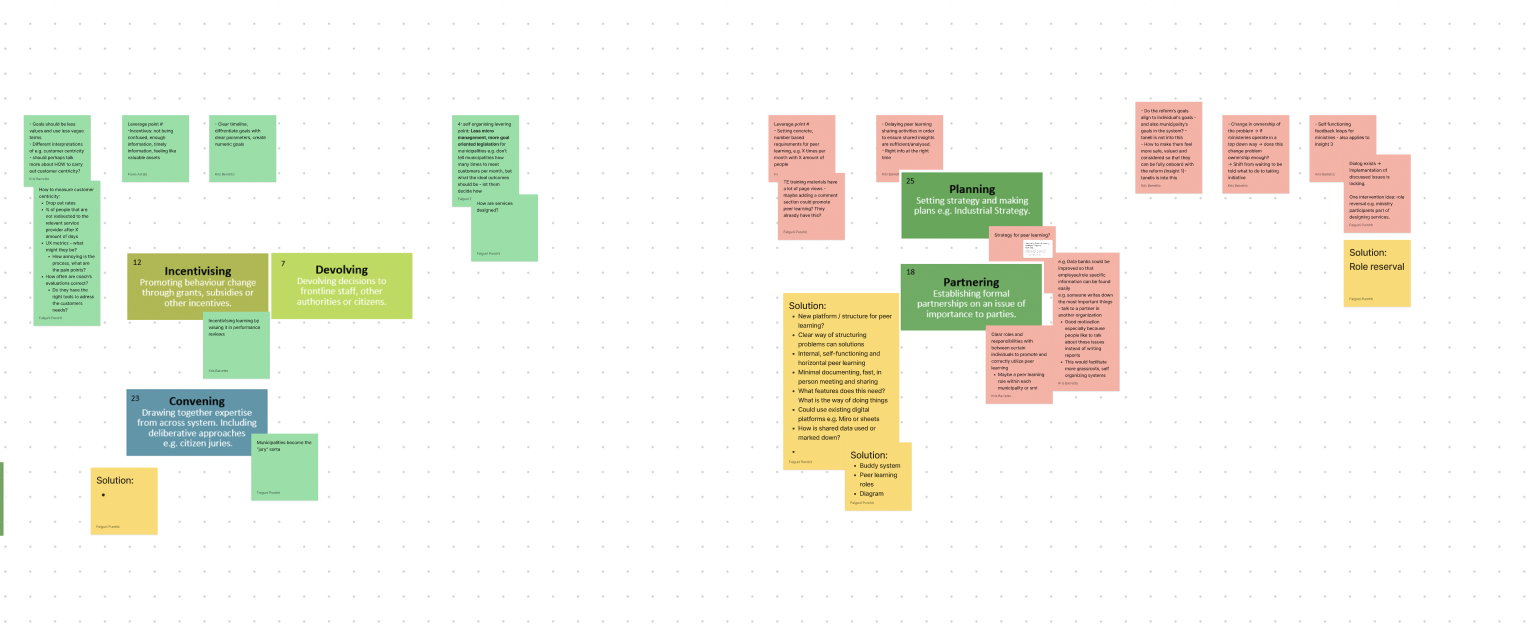This blog post reports on work-in-progress within the DfG course! The post is written by group 2A dealing with the Ministry of Finance’s brief on Orchestrating public governance in employment services (TE2024) by focusing on the public servants’ needs in the new reform model. The group includes Kristen Barretto from the Collaborative and Industrial Design program, Frans Astala and Florencia Pochinki from the Creative Sustainability program and Falguni Purohit from the International Design Business Management program at Aalto University.
Written by: Florencia Pochinki
Finding the Leverage Points
The starting point of these past two weeks work have been the identification of 3 main problem areas, in which we could potentially intervene. These 3 areas are:
- TE employees involved in the reforms planning process
- The goal overlap between different ongoing reforms, which leads to a lack of motivation in implementing either one effectively
- The vicious cycle of having no time for peer-learning due to the burdensome task of creating new organisations even though peer-learning would reduce this burden.
In order to move forward from this step we engaged in an analytical process in order to understand deeper how and where our interventions could take place. In order to do so, we used Meadow’s framework on Leverage Points. This frameworks aims to identify the places within a complex system where a small shift can produce big changes. Nevertheless, we always kept critical about not trying to find the “silver bullet”, understanding that we aim to focus in a concrete and feasible solution that will generate some sort of positive impact for the implementation of the TE2024 reform.
Following the twelve leverage points by Meadows, – which are numbered in increasing order of effectiveness – we tried to come up with a wide number of possible interventions for the three different areas.

These exercise sparked enriching conversations and allowed us to understand were our intervention could be more effective. After having a deeper analysis of different layers of the 3 big areas new perspectives emerged. This also helped us identify common themes across most of the problem areas. This is the case of the top-down current structure which passes information from the ministers to the municipalities and TE employees. This is why, we decided to position this at the core of our design intervention.
Moving Towards Our design Intervention
Our starting point question was: how could we then incorporate more collaborative and horizontal structures in order to facilitate the peer learning? In this stage, we engage in the process of an ideation mapping. In order to do so, we used the Policy-Lab toolkit to frame our ideation using the government actions. This method, in dialogue with the thoughts that emerged from the leverage point’s framework, allowed us to develop some initial possible desired scenarios, following this criteria:
- We wanted to focus on creating structures for peer learning that allow horizontal flows of information
- Focus on the current existing digital platforms that are already in use
- Needs to be self-functioning and grassroots; non-dependant of external organisations
- Develop fast ways to document existing good practices that can be useful to others
- Collaborative ways of storing information
- Not only use digital channels but also physical
- Create spaces that are designed for peer learning and sharing knowledge
- Tools that facilitate conversations
- Encourage motivation form employees and cherish peers
At the moment we are still in the process of developing a more clear and straightforward design intervention. We are focusing on a strategy that enables peer learning in the future.
Potential ideas
In an effort to be more concrete, I want to share some of the ideas that emerged from our ideation sessions. One idea is to create spaces and allocate specific time in which exchange between different employees occur. It could be a specific time of the week that is assigned for this purpose, and in which tools are provided to facilitate knowledge exchange. Moreover, there could be the creation of a series of “Ted-talks” where employees can propose topics that they think are relevant, or present good practices. Organising a hackathon as well of a library of good practices were also explored.
Next steps
Having the how clear, our next step is to define the how. Although there were some concrete ideas that emerged, as previously mentioned, we still need to decide what shape and form our intervention will have. Some decisions we need to make to move forwards are:
Is a new role position needed? Does our intervention need to be a long term strategy plan? Or a concrete set of peer learning tools ready to implement?
The DfG course runs for 14 weeks each spring – the 2022 course has now started and runs from 28 Feb to 23 May. It’s an advanced studio course in which students work in multidisciplinary teams to address project briefs commissioned by governmental ministries in Finland. The course proceeds through the spring as a series of teaching modules in which various research and design methods are applied to address the project briefs. Blog posts are written by student groups, in which they share news, experiences and insights from within the course activities and their project development. More information here about the DfG 2022 project briefs. Hold the date for the public online finale online 09:00-12:00 AM (EEST) on Monday 23 May!

